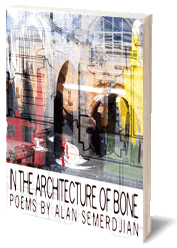An Impressive Debut:
Alan Semerdjian’s In the Architecture of Bone
By Arpi Sarafian
I have lost my voice;
Who will hear my song?
–
Alan Semerdjian
“I was born here, in a three-bedroom apart/ment overlooking Broadway. Everyone I/ knew to be family lived in that building,” writes Alan Semerdjian in an untitled prose poem in his recently published collection In the Architecture of Bone (GenPop Books 2009). With his images and his rhythms, Alan brings to life a personal world of old-country traditions and family life. His poems take us into the Semerdjian family room where “the women sang stories like gypsies,” and where “my mother …and before that, her mother” read their fortune in a cup of Turkish coffee.
Evoked in the poems is a special history, a history of interrupted lives. The references to the 1915 Armenian Genocide and to the grandfather’s memories in the rehabilitation facility in New York of “’the school of orphan’….surrounded by genocide children” do not, however, create a boundary around Armenianness. Alan’s deep sense of what it means to be alive today and his insights into life’s deeper Truths extend the reader’s perceptions to something larger. No specialized knowledge is necessary to appreciate the infinite truth of, “Genocide is…… the quiet forget/ting and/what’s left inside/when the forget/ting/won’t forget.”
What inevitably comes through in the 36 poems assembled in the volume is the immediacy of the lived moment. Carefully chosen words and keenly observed details help the reader participate in the poet’s encounters with the world around him. “One blue afternoon I saw my mother spin/her own cup. I remember how she swirled its/insides,loosening the essential fibers at the/bottom, then turned it over. The tiny layer of/thick mud poured into the saucer’s curves. Its/descent was slow and complete; the handle/of the cup, upside down now, looked like an/Armenian nose,” is a moment we share with the young boy who “marked [his] height against the hall/closet door” as the women “read each other’s minds.”
Almost always, the present connects to what has happened in the past. “The young in the family couldn’t wait to grow up, their/tongues hanging out for coffee and a lick of/the old country,” is a subtle reference to a lost country, a loss that is further evoked by, “What could she/read in the bottom of that cup of coffee that/she didn’t help write?” The trauma of dislocation is even more forcefully conveyed in the cinquain, “Immigrant”: “I am/in a stolen/and revolted language/not the one invented or born/into.”
Ultimately, it is the young poet’s craft, his love of words and feeling for rhythm, that make this debut collection a joy to read. Alan experiments with line and stanza divisions transforming prose sentences into rhythmic verbal pictures. His sensitivity to words, on the other hand, both English and Armenian, and the exploration of their meanings, capture the complexities and the paradoxes of the immigrant experience. “My mother called it soorj, the Armenian/word for coffee. And when she translated it to/me and my American friends, it was Turkish/coffee. It was always Turkish coffee. And it was/easy to remember that way,” he writes in “How Turkish Coffee Got Its Name.”
Alan’s precise images also attract our attention, giving us a more intense understanding of what he is trying to communicate. In “Fragments of A Composition with Grandfather” the poet writes of his grandfather, still speechless, trying to remember “the war, his/wife, the world.” “Watch as he forgets everything else: forgets the stained mug of/water in the refrigerator,/the kettle on the flame, his daughter’s name. Watch as he leaves/the door open/in denial, as if his mind might walk through” is startlingly fresh. Alan’s expressions may sometimes elude us but his lines make us think. I pondered long the meaning of “This is how memory invents itself, in the crooked door/ways, in the architecture of bone.”
In Architecture a fragmented world achieves cohesion. Rather than made into a terrifying place, the tragedy transforms into a celebration of “the idea of family” invoked in the dedication. The grandfather ”paints to elevate/everything flattened and dry.” The grandson, on the other hand, sings songs which illuminate the mother’s need for “the safety/of home, the hallway, a life/next door to her mother/and father”and, why not, “The shackles of my mother/and all Armenian women” around their sons.
Semerdjian fulfills the promise of the epigraph, ”Perhaps it is our function to illuminate some dark corner of the universe” (Gostan Zarian). His poems do indeed deepen our understanding of our own experiences. “Typically, I should know more/than a few words–most Turks know a little/Armenian; most Armenians know a lot of/Turkish–but I wasn’t born there” is a poignant reminder–because so sudden–of the disruption caused by one’s removal from one’s roots.
[Click here to visit the webpage for Alan Semerdjian’s In the Architecture of Bone.]




